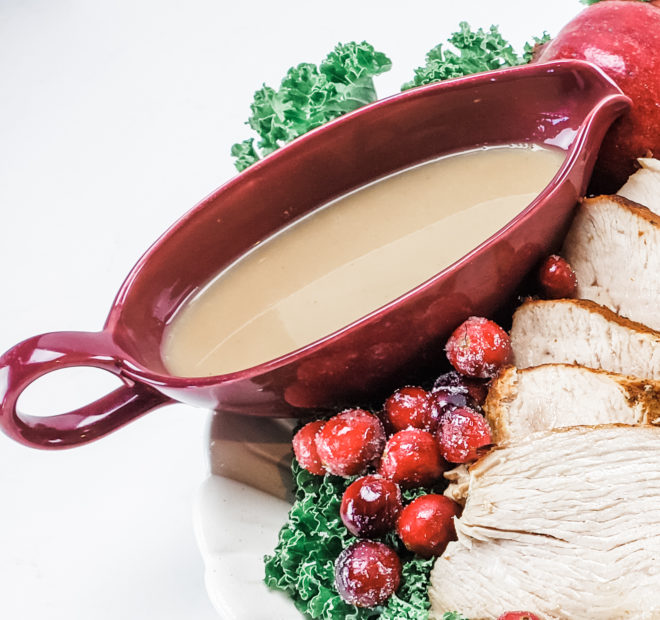If you’re just cooking a turkey breast for Thanksgiving, or if your turkey didn’t provide you with any drippings, you need to know how to make the best turkey gravy without drippings!
Doctor up your Thanksgiving turkey tenderloin or boneless turkey breast with the best turkey gravy without drippings!
*If you’re using regular table salt, start with only 1/4 teaspoon (it tastes saltier than sea salt does). Then adjust to taste from there.
As Thanksgiving approaches, many home cooks start planning their holiday menus For most, turkey and gravy are non-negotiable The savory, silky gravy adds so much flavor and moisture to the turkey, potatoes, stuffing, and more. It brings the whole meal together.
But what if you don’t have those flavorful pan drippings from roasting a turkey? Don’t panic! You can still make impeccable gravy without them,
I have made gravy without drippings for years. My family deep fries our turkey, so there are never any drippings. Through trial and error, I’ve landed on a simple method for gravy packed with rich, meaty flavor using just pantry staples.
In this article, I’ll explain my easy, foolproof process for gravy success without drippings or roasting a turkey. You’ll also find tips on enhancing flavor, fixing common gravy mishaps, storing and reheating leftover gravy, and customizing it for different diets.
Let’s get started!
The Key Gravy Ingredients
Here are the main ingredients I use to make dynamite gravy without drippings:
-
Broth or stock: This provides the base flavor. Chicken, turkey, beef or vegetable broth all work beautifully. I like to use low-sodium broth and season it myself.
-
Butter: I prefer unsalted, but you can substitute salted butter or oil if you prefer. The fat is crucial for making the roux.
-
Flour: All-purpose flour thickens the gravy and should be whisked to prevent lumps.
-
Seasonings: Salt, pepper and herbs like thyme, sage or poultry seasoning add flavor. Get creative with spices!
Step 1: Make a Roux
The secret to incredible gravy without drippings starts with making a simple roux.
-
Melt the butter in a saucepan over medium heat.
-
Whisk in an equal amount of flour until smooth.
-
Cook for 2-3 minutes, until the mixture turns light golden brown.
This combination of fat and flour thickens the gravy and adds nutty, toasted flavor.
Step 2: Slowly Add Broth
Once your roux is ready, it’s time to add the broth.
-
Bring the broth to a simmer in a separate pot.
-
Slowly whisk the hot broth into the roux a little at a time.
-
Keep whisking vigorously to prevent lumps!
-
Simmer until thickened, about 5 minutes.
At first, the gravy will appear thin. But don’t worry, it will gradually thicken as the starch from the flour absorbs the liquid.
Step 3: Season and Serve!
After cooking for a few minutes, the gravy is ready for its finishing touches.
-
Add any extra seasonings you like. Get creative!
-
Taste and add salt and pepper as desired.
-
Garnish with fresh herbs.
And that’s it – smooth, luxurious gravy without the drippings! Now ladle it over everything on your holiday table.
Flavor Boosters
If you want an extra flavor punch, try adding any of the following as you simmer the gravy:
-
Minced onion and garlic
-
Diced mushrooms
-
Thyme, sage, rosemary or parsley
-
A splash of soy sauce or Worcestershire
-
Dash of cider vinegar
-
Spoonful of concentrated turkey or chicken bouillon
Handy Tips for No-Drippings Gravy
Getting lumps out: Strain the gravy through a mesh sieve if any flour lumps sneak in.
Thinning: Whisk in extra broth or water to thin.
Thickening: Simmer longer to reduce or make a slurry with cornstarch.
Storing: Refrigerate up to 4 days or freeze for 4-6 months.
Reheating: Gently reheat on the stovetop, adding more liquid as needed.
Customizing Your Gravy
You can easily adapt this easy gravy recipe:
-
For vegetarian gravy, use vegetable broth.
-
For vegan gravy, use oil instead of butter and vegetable broth.
-
For gluten-free gravy, use cornstarch or gluten-free flour instead.
-
For lower sodium, use unsalted butter and no-salt-added broth.

How To Make Turkey Gravy Without Drippings
Start by melting the butter in a saucepan. Once the butter has melted, add in the garlic and dried thyme. Saute until the garlic and thyme are aromatic. (See the recipe card below for the full written instructions.)

Add in the flour and whisk to create a roux. Continue whisking the roux while cooking it until it’s a deeper golden color.

Slowly add in the broth while whisking constantly. Once all of the liquid has been incorporated, whisk in the poultry seasoning and black pepper.

Simmer the gravy until it has thickened. See the recipe card below for the full written instructions, including ingredient amounts, cooking times, and helpful tips, etc.

What To Add To Turkey Gravy To Make It Taste Better?
Nobody wants bland gravy. To make gravy more flavorful try cooking the roux for a few minutes before adding the rest of the ingredients. Letting that roux darken adds a lot of flavor. I also like adding some poultry seasoning into my turkey gravy to lean into the classic Thanksgiving flavors.

Turkey Gravy | How To Make Turkey Gravy Without Pan Drippings | Thanksgiving Recipes | Ep. 479
FAQ
What to do if turkey has no drippings?
What is the best thickener for turkey gravy?
Is stock or broth better for turkey gravy?
